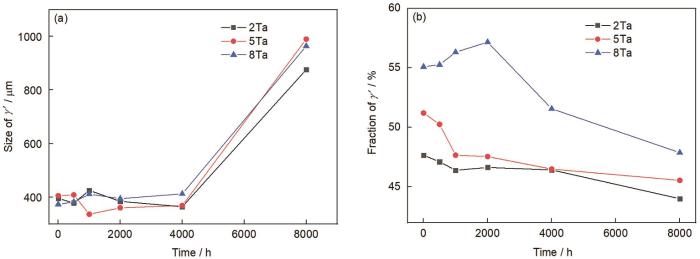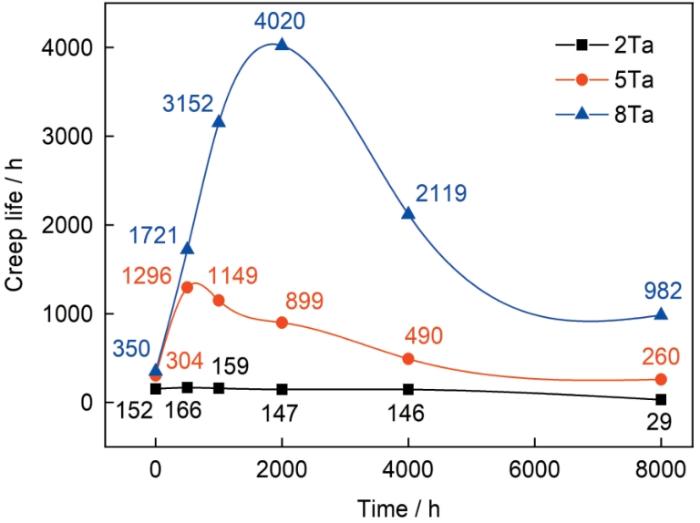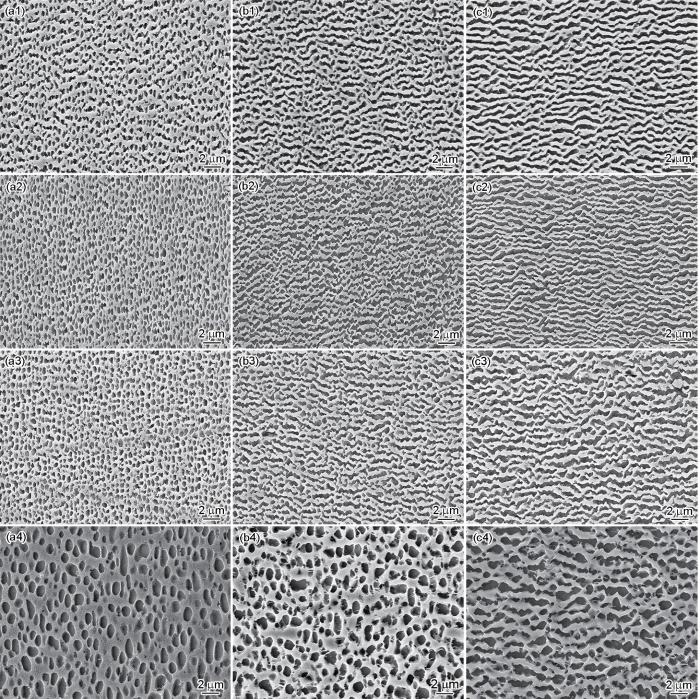抗热腐蚀镍基单晶高温合金因其优异的蠕变、疲劳、抗氧化及腐蚀等综合性能,成为制造燃气轮机涡轮叶片的关键材料[1,2]。工业燃气轮机涡轮叶片需在高温、高离心应力和热腐蚀等复杂环境下稳定运行上万小时,因此合金组织和力学性能的长期稳定是保证燃机安全服役的关键[3]。研究[4~11]表明,燃机叶片用高温合金经长时服役后,合金组织及性能会出现不同程度的损伤退化,严重影响叶片的使用。如在组织退化方面,主要表现在γ'相粗化、拓扑密排(topological close-packed,TCP)有害相的析出和MC碳化物退化现象等。在性能退化方面,蠕变初始状态中γ'相体积分数降低、γ'相粗化(未形成筏排组织)以及蠕变过程中筏排厚度减小、γ基体通道变宽和TCP相析出均导致合金蠕变性能不断降低[4,5,12]。
近年来,为提高蠕变性能,抗热腐蚀高温合金中W、Mo、Ta、Re等难熔元素含量不断增加。然而,W、Mo会显著恶化合金的抗热腐蚀性能,Re易促进TCP相析出并增加合金成本。因此,Ta成为提高抗热腐蚀合金性能的关键元素。关于Ta元素提高合金性能已有大量文献报道[13~16]。Ta的添加可同时强化γ基体和γ'相,提高γ'相体积分数,提高合金扩散激活能和组织稳定性。Ta元素可以显著提高合金的γ /γ'两相错配度,形成较大的弹性应力场,有效阻碍位错运动,进而提高合金的蠕变性能[13,17]。同时,Ta的添加还能够推迟或阻止服役过程中碳化物的退化分解(MC + γ → γ'+M23C6)[18]。另外,Ta的添加可促进合金固态NaTaO3相的形成,抑制液态Na2Mo(W)O4相的生成以及合金熔融反应的发生,延长合金的热腐蚀孕育期,从而改善镍基单晶高温合金的抗热腐蚀性能[19~23]。
目前,关于Ta对抗热腐蚀镍基单晶高温合金在长时热暴露过程中组织演化和蠕变性能的影响研究较少。本工作通过设计不同Ta含量抗热腐蚀镍基单晶高温合金并进行热暴露和蠕变实验,研究了Ta含量对合金热暴露和蠕变断后γ'相形貌演变的影响,进一步分析组织演变对合金热暴露后蠕变性能的影响,以期为先进燃气轮机用高强抗热腐蚀合金的发展积累实验数据,奠定理论基础。
1 实验方法
实验所用合金为3种不同Ta含量的抗热腐蚀镍基单晶高温合金,合金成分如表1所示。单晶试棒采用传统高速凝固(high rate solidification,HRS)Bridgman法制备,并利用电子背散射衍射(EBSD)技术测定铸态单晶试棒<001>取向,实验合金取向差小于8°。试棒经热处理(如表2所示)后进行900℃热暴露实验,热暴露时间分别为500、1000、2000、4000和8000 h。另外,试棒经不同时间热暴露后进行900℃、275 MPa蠕变测试,其中蠕变试样标距段长度为25 mm、直径为5 mm。3种合金热处理态、热暴露态、蠕变中断(从样品标距段中部切取)及蠕变断后(断口附近)样品经过标准金相制样后,利用MIRA3型场发射扫描电子显微镜(SEM)对样品进行微观组织观察。为方便观察合金微观组织形貌,采用硫酸铜腐蚀剂(4 g CuSO4 + 10 mL HCl + 20 mL H2O)对样品进行腐蚀。3种合金热处理态枝晶干和枝晶间γ和γ'相的元素含量利用Tecnai G2-20透射电镜(TEM)附带的能谱仪(EDS)进行测定。TEM样品采用双喷减薄,电解液为:10%高氯酸 + 90%酒精溶液(体积分数),双喷温度和电流分别为-25℃和20 mA。γ'相的平均尺寸、体积分数、γ'相筏排通道宽度和γ相基体通道宽度利用Photoshop绘图软件和Image-Pro Plus统计软件进行统计和计算,γ'相体积分数利用γ'相面积分数代替。
表1 实验用抗热腐蚀镍基单晶高温合金的成分 (mass fraction / %)
Table 1
| Alloy | Al + Ti | Cr | Co | Mo | W | C | Re | Ta | Ni |
|---|---|---|---|---|---|---|---|---|---|
| 2Ta | 7.6 | 9.8 | 8.3 | 0.47 | 4.5 | 0.039 | 1.93 | 1.9 | Bal. |
| 5Ta | 7.5 | 9.7 | 8.2 | 0.47 | 4.5 | 0.038 | 1.92 | 5.2 | Bal. |
| 8Ta | 7.4 | 9.5 | 8.2 | 0.47 | 4.5 | 0.038 | 1.93 | 8.1 | Bal. |
表2 抗热腐蚀镍基单晶高温合金的热处理参数
Table 2
| Alloy | Heat treatment |
|---|---|
| 2Ta | 1245oC, 4 h, AC + 1120oC, 4 h, AC + 870oC, 20 h, AC |
| 5Ta | 1265oC, 4 h, AC + 1130oC, 4 h, AC + 870oC, 20 h, AC |
| 8Ta | 1275oC, 4 h, AC + 1130oC, 4 h, AC + 870oC, 20 h, AC |
2 实验结果
2.1 合金热处理态组织形貌
图1为热处理后3种合金横截面的SEM像。可见,热处理后3种合金的枝晶间区域除了γ相和γ'相外,还存在少量碳化物、γ + γ'残余共晶组织和粗大γ'相。随Ta含量的增加,γ + γ'残余共晶组织和粗大γ'相含量有所增多。图2给出了热处理后3种合金横截面枝晶干的SEM像。可见,γ'相呈立方体状,γ基体中有三次γ'相析出。经测量,2Ta、5Ta和8Ta合金的γ'相平均尺寸分别约为395、405和373 nm,γ'相的平均体积分数分别约为47.66%、51.20%和55.09%。对比图2中的组织可以发现,随Ta含量的增加,γ基体中三次γ'相数量明显减少,γ'相立方度和体积分数不断增加,而尺寸无明显变化。
图1
图1
热处理后3种合金横截面的SEM像
Fig.1
Cross sectional SEM images of 2Ta (a), 5Ta (b), and 8Ta (c) alloys after heat treatment
图2
图2
热处理后3种合金横截面枝晶干的SEM像
Fig.2
SEM images of dendritic core at cross section of 2Ta (a), 5Ta (b), and 8Ta (c) alloys after heat treatment
γ /γ'两相中合金元素分配行为一般由成分分配比(
式中,
图3为利用TEM-EDS结果计算得到的3种合金中元素在γ'和γ相中的分配比。可见,Re、W、Cr和Co元素主要富集在γ相中,而Al、Ti和Ta元素主要富集在γ'相。随Ta含量的增加,Ta在γ和γ'两相中的分配比增加,W的分配比降低。
图3
图3
3种合金中元素在γ和γ'相中的分配比
Fig.3
Partitioning ratios of alloying elements in γ and γ' precipitates of three alloys in dendritic core (a) and interdendrite (b)
2.2 合金长时热暴露过程中γ' 相演化行为
图4为3种合金在900℃长时热暴露后枝晶干的SEM像。从图中可以发现,随热暴露时间的延长,相比于热处理态合金(图2),热暴露500 h后2Ta (图4a1)和5Ta (图4b1)合金γ基体中三次γ'相数量有所增多,其中5Ta合金明显低于2Ta合金,而8Ta合金(图4c1)基体中几乎未观察到尺寸较小的三次γ'相。随热暴露时间进一步延长,2Ta合金(图4a2~a4) γ基体中三次γ'相数量不断减少,尺寸不断增大,而5Ta (图4b2~b4)和8Ta (图4c2~c4)合金基体中几乎未观察到尺寸较小的三次γ'相。随热暴露时间延长至8000 h,3种合金中γ'相均出现明显的粗化和长大,其中2Ta合金γ'相球化程度(图4a5)要明显大于5Ta和8Ta合金(图4b5和4c5)。图5给出了3种合金在900℃热暴露不同时间枝晶干γ'相尺寸和平均体积分数。由图5可知,3种合金的γ'相尺寸均在热暴露8000 h时出现明显增大(图5a)。2Ta合金的γ'相体积分数随热暴露时间的延长不断降低,热暴露0~4000 h期间降幅较小,热暴露8000 h时降幅增大;5Ta合金在热暴露500 h时略有下降,在热暴露1000 h时降幅增大;8Ta合金γ'相体积分数随热暴露时间的延长先增加,在热暴露2000 h后明显降低(图5b)。常用形状参数比(η)来反映γ'相的球化程度,计算公式如下[24]:
图4
图4
900℃热暴露不同时间后3种合金枝晶干的SEM像
Fig.4
SEM images at dendritic core of 2Ta (a1-a5), 5Ta (b1-b5), and 8Ta (c1-c5) alloys during thermal exposure at 900oC for 500 h (a1-c1), 1000 h (a2-c2), 2000 h (a3-c3), 4000 h (a4-c4), and 8000 h (a5-c5)
图5
图5
3种合金在900℃热暴露不同时间时枝晶干γ'相尺寸和平均体积分数
Fig.5
Sizes of γ' precipitates at dendritic core regions (a) and average volume fractions of γ' precipitates (b) for three alloys during long-term thermal exposure at 900oC
2.3 合金长时热暴露后蠕变性能
图6给出了900℃热暴露不同时间后3种合金在900℃、275 MPa 条件下的应变-时间曲线。由图可知,随Ta含量的增加,热暴露不同时间后的稳态蠕变速率(
图6
图6
900℃热暴露不同时间后3种合金在900℃、275 MPa 条件下的应变-时间曲线
Fig.6
Strain-time curves of three alloys at 900oC and 275 MPa after thermal exposure at 900oC for 0 h (a), 500 h (b), 1000 h (c), 2000 h (d), 4000 h (e), and 8000 h (f) (
图7
图7
900℃热暴露不同时间后3种合金900℃、275 MPa 蠕变寿命的变化
Fig.7
Variation of creep life of three alloys at 900oC and 275 MPa after thermal exposure at 900oC with various thermal exposure time
2.4 合金蠕变断裂后纵截面γ' 相组织形貌
图8为900℃热暴露不同时间后3种合金在900℃、275 MPa条件下蠕变断裂后纵截面枝晶干的SEM像。合金热暴露1000和4000 h组织与热暴露500和2000 h较为相似,因此未在文中展示。从图8a1~a4可见,2Ta合金除热处理态蠕变断裂后γ'相出现简单连接合并外,其余状态下均为球状,且热暴露8000 h时γ'相尺寸明显增大。5Ta合金热暴露前4000 h蠕变断后均为γ'相筏排结构,热暴露8000 h时则为尺寸较大的球状γ'相(图8b1~b4)。8Ta合金在整个热暴露过程中均为γ'筏排结构,但热暴露8000 h时γ'筏排结构尺寸较大且不完善(图8c1~c4)。由图8可知,随Ta含量的提高,合金热暴露后蠕变过程中γ'相筏化驱动力增加,蠕变断裂后γ'筏排结构更加完善。图9为900℃热暴露不同时间后5Ta和8Ta合金900℃、275 MPa条件下蠕变断裂后纵截面枝晶干的γ'相筏排厚度和γ通道宽度。当热暴露时间小于4000 h时,随热暴露时间的延长,5Ta合金γ'相筏排厚度先增加后降低,8Ta合金γ'相筏排厚度有所波动,2种合金γ'相筏排厚度峰值分别出现在热暴露500和2000 h时(图9a)。8Ta合金热暴露8000 h时γ'相筏排厚度虽然较大,但其γ'筏排结构不完善且γ基体通道较宽。另外,2种合金γ基体通道宽度的波动较大,但均在热暴露500 h时出现最小值(图9b)。
图8
图8
3种合金在900℃热暴露不同时间后在900℃、275 MPa 条件下蠕变断裂后纵截面枝晶干的SEM像
Fig.8
SEM images of dendritic core at longitudinal section in 2Ta (a1-a4), 5Ta (b1-b4), and 8Ta (c1-c4) alloys crept rupture at 900oC and 275 MPa after thermal exposure at 900oC for 0 h (a1-c1), 500 h (a2-c2), 2000 h (a3-c3), and 8000 h (a4-c4)
图9
图9
900℃热暴露不同时间后5Ta和8Ta合金900℃、275 MPa 条件下蠕变断裂后纵截面枝晶干的γ' 筏排厚度和γ基体通道宽度
Fig.9
Thicknesses of rafted γ' (a) and widths of γ channel (b) of dendritic core at longitudinal section of 5Ta and 8Ta alloys crept rupture at 900oC and 275 MPa after thermal exposure at 900oC with various thermal exposure time
3 分析讨论
3.1 Ta对长时热暴露过程中γ' 相演化的影响
合金中γ'相的形貌与合金错配度(δ)的大小有关[25]:当δ = 2(aγ' –aγ ) /(aγ' + aγ ) (其中,aγ' 为γ'相的晶格常数,aγ 为γ相的晶格常数)较小时,两相的应变能较小,γ'相的形貌主要受合金界面能控制。合金界面能与γ /γ'相界面面积成正比,在体积相同的情况下,球形的面积最小。由于合金结构的演化总是朝着体系总能量降低的方向进行,因此,γ'相趋向于球化。当合金错配度增大后,γ'相形貌主要受晶格错配引起的弹性应变能控制,由于<001>取向弹性模量最小,因此,γ'相向不同的<001>方向生长而形成立方体形貌。Ta的加入增大了合金γ /γ'两相错配度[13],因此,随着Ta含量的提高,在热暴露0~4000 h过程中,合金中γ'相立方度不断提高。随热暴露时间的延长,γ /γ'两相中合金元素重新分配,引起错配度的改变,从而导致γ'相形貌变化。在热暴露4000~8000 h过程中,随着γ'相长大,界面能成为控制γ'相形态变化的主要因素。当γ'相形貌保持稳定时,只能通过不断的粗化和连结来减小γ /γ'界面面积,从而使合金整体的界面能不断降低[7]。
由于本工作中热暴露温度与合金二级时效温度非常接近,所以在热暴露过程中γ'相会继续析出。Ta是γ'相形成元素,因此,Ta含量的增加会促进更多的γ'相析出。因此,随着热暴露时间的延长,合金中γ'相完全析出(体积分数最大时)的时间不断向后推移。2Ta合金热处理后γ'相就已完全析出,而5Ta和8Ta合金γ'相完全析出时间分别在热暴露500和2000 h时。
3.2 热暴露组织演化对合金蠕变性能的影响
式中,μ为剪切模量;b为位错Burgers矢量模;υ为Poisson比;lS为位错在γ基体中的长度,
如图7所示,随热暴露时间的延长,3种合金蠕变性能变化略有差异,其中组织差异是造成蠕变性能变化差异的主要原因。2Ta合金热暴露0~4000 h过程中,γ'相体积分数出现小幅下降(图5b),但因γ基体中三次γ'相不断长大(图4a1~a4),使得蠕变过程中γ基体通道宽度未出现明显增加。而热暴露8000 h时γ'相尺寸明显增大(图5a),造成γ基体通道显著变宽(图4a5),使得合金性能严重下降。同时热暴露8000 h时γ'相体积分数的降低(图5b)同样对基体通道变宽产生促进作用。因此,热暴露8000 h时蠕变寿命出现显著下降。Murakumo等[32]发现,γ'相筏排越薄越易被位错对剪切,一旦位错对剪切γ'相筏排结构发生,蠕变速率则随之增加。也有研究[6]表明,最小蠕变速率与γ'相筏排厚度呈反比。Kondo等[35]研究发现,最小蠕变速率随γ相基体通道宽度的增加呈线性提高的趋势。由图9可知,随热暴露时间的延长,5Ta合金蠕变断后γ'相筏排厚度先增后减,在热暴露500 h时达到峰值,同时γ基体通道宽度也在热暴露500 h后达到极小值。其中热暴露500 h时γ基体中三次γ'相数量的增多(图4b1),促进了合金蠕变过程中γ基体通道变窄。另外,5Ta合金γ'相体积分数从热暴露1000 h开始明显降低,但尺寸在热暴露8000 h时才明显增加,且热暴露8000 h蠕变断后未形成γ'相筏排结构,γ基体通道明显变宽。因此,5Ta合金蠕变寿命峰值出现在热暴露500 h。8Ta合金热暴露0~4000 h过程中γ'相体积分数(图5b)随热暴露时间的延长,先增加后降低,在热暴露2000 h时达到峰值,γ'相筏排厚度也在热暴露2000 h达到峰值,同时γ'相尺寸在热暴露前4000 h无明显变化。热暴露8000 h时,γ'相尺寸明显增加,体积分数明显下降,蠕变断后γ'基体通道宽度明显变宽,与热暴露0~4000 h的合金相比,其力学性能显著下降。因此,8Ta合金热暴露后蠕变寿命峰值出现在2000 h。需要说明的是,热暴露8000 h时蠕变断后γ'相筏排厚度仍较厚,同时因难熔元素Ta含量较高,γ'相仍具有较强的抵抗位错对剪切的能力,使得热暴露8000 h后蠕变寿命(982 h)仍明显高于热处理态合金(350 h)。
综上,蠕变初始状态中γ'相体积分数的增加、蠕变过程中γ'相筏排完整度和厚度的增加均能够有效降低合金的稳态蠕变速率,提高合金蠕变性能。与此同时,γ'相较高的立方度、难熔元素含量和反向畴界能也有利于合金蠕变性能的提升。
4 结论
(1) 随热暴露时间的延长,3种合金γ'相尺寸均在热暴露8000 h时出现明显增大,2Ta合金的γ'相体积分数随热暴露时间的延长不断降低,在热暴露0~4000 h期间降幅较小,在8000 h时降幅增大;5Ta合金在热暴露500 h时略有下降,在1000 h时出现明显的降低;8Ta合金γ'相体积分数随热暴露时间的延长先增加,在热暴露2000 h后开始明显的降低。随着Ta含量的提高,热暴露不同时间后,γ'相尺寸无明显变化,立方度有所增加,γ基体中的三次γ'相数量减少。随Ta含量由2%增加到5%,除热暴露4000 h时2种合金γ'相体积分数较为接近外,其余热暴露时间下5Ta合金的γ'相体积分数均高于2Ta合金;随Ta含量进一步增加至8%,热暴露不同时间后γ'相体积分数均有所增加。
(2) 随热暴露时间的延长,3种合金的900℃、275 MPa 蠕变性能变化趋势存在差异:2Ta合金热暴露0~4000 h蠕变性能无明显变化,热暴露8000 h后性能明显降低;5Ta和8Ta合金蠕变性能随热暴露时间的延长均先提高后降低,分别在热暴露500和2000 h时达到峰值。随Ta含量的增加,合金稳态蠕变速率不断降低、蠕变寿命明显增加、峰值蠕变寿命向后推移,同时蠕变断后γ'相筏化程度和筏排结构完整度明显提高。
(3) 蠕变初始状态中γ'相体积分数的提高、蠕变过程中γ'相筏排完整度和厚度的增加是合金蠕变性能提升的主要原因。
参考文献
Review of blade materials for IGT
[J].
Failure analysis of gas turbine buckets
[J].
Advanced materials for land based gas turbines
[J].
The effect of long-term thermal exposures on the microstructure and properties of CMSX-10 single crystal Ni-base superalloys
[J].
Effects of Ta on microstructural stability and mechanical properties of hot corrosion resistant Ni-based single crystal superalloys during long-term thermal exposure
[J].
Effects of rhenium and tantalum on microstructural stability of hot-corrosion resistant single crystal superalloys aged at 900oC
[J].
Re和Ta对抗热腐蚀单晶高温合金900℃长期时效组织稳定性的影响
[J].
Microstructural evolution of an experimental third generation single crystal superalloy after long-term thermal exposure at 1100oC
[J].
The microstructure evolution and its effect on the mechanical properties of a hot-corrosion resistant Ni-based superalloy during long-term thermal exposure
[J].
Influence of TCP phase and its morphology on creep properties of single crystal nickel-based superalloys
[J].
Effects of long-term thermal exposure on the microstructure and properties of a cast Ni-base superalloy
[J].
Effect of thermal exposure on stress rupture properties of a Re bearing Ni-base single crystal superalloy
[J].
Thermal-stress coupling effect on microstructure evolution of a fourth-generation nickel-based single-crystal superalloy at 1100oC
[J].
热力耦合对一种第四代镍基单晶高温合金1100℃蠕变组织演变的影响
[J].
Effect of Ta on microstructural evolution and mechanical properties of a solid-solution strengthening cast Ni-based alloy during long-term thermal exposure at 700oC
[J].
On the influence of Ta and Ti on heat-treat ability and γ /γ'-partitioning of high W containing Re-free nickel-based superalloys
[J].
Effect of long-term aging on microstructure evolution and creep properties of Ni-based single crystal superalloy
[J].
Effect of thermal exposure on the stress-rupture life and microstructure of a low Re-containing single crystal alloy
[J].
Effects of tantalum on the temporal evolution of a model Ni-Al-Cr superalloy during phase decomposition
[J].
The effects of Ta on the stress rupture properties and microstructural stability of a novel Ni-base superalloy for land-based high temperature applications
[J].
Effect of refractory elements and Al on the high temperature oxidation of Ni-base superalloys and modelling of their oxidation resistance
[J].
High-temperature oxidation behavior of low Cr and high W content cast Ni-base superalloys and effect of Ta alloying
[J].
低Cr高W铸造镍基高温合金的高温氧化行为及Ta的合金化作用
[J].
Interaction of Ta and Cr on Type-I hot corrosion resistance of single crystal Ni-base superalloys
[J].
Mechanism of beneficial effect of tantalum in hot corrosion of nickel-base superalloys
[J].
Chemical reactions involved in the initiation of hot corrosion of IN-738
[J].
Optimal precipitate shapes in nickel-base γ-γ' alloys
[J].
TEM analyses of microstructure evolution in ex-service single crystal CMSX-4 gas turbine blade
[J].
Creep resistance of single crystal superalloys CMSX-4 and CM186LC
[J].
High-temperature dislocation climb in the γ' rafts of single-crystal superalloys: The hypojournal of a control by dislocation entry into the rafts
[J].
On rafting in a single crystal nickel-base superalloy after high and low temperature creep
[J].
Directional coarsening in nickel-base single crystals with high volume fractions of coherent precipitates
[J].
Origin of localized rafting in Ni-based single crystal turbine blades before service and its influence on the mechanical properties
[J].
Creep behaviour of Ni-base single-crystal superalloys with various γ' volume fraction
[J].
The effect of the lattice strains on the directional coarsening of γ' precipitates in Ni-based alloys
[J].
Effects of Ta on microstructure and creep mechanism of a Ni-base single crystal superalloy
[J].
Ta对一种镍基单晶合金微观组织及蠕变机制的影响
[J].
Effect of morphology of γ' phase on creep resistance of a single crystal nickel-based superalloy, CMSX-4
[A].













